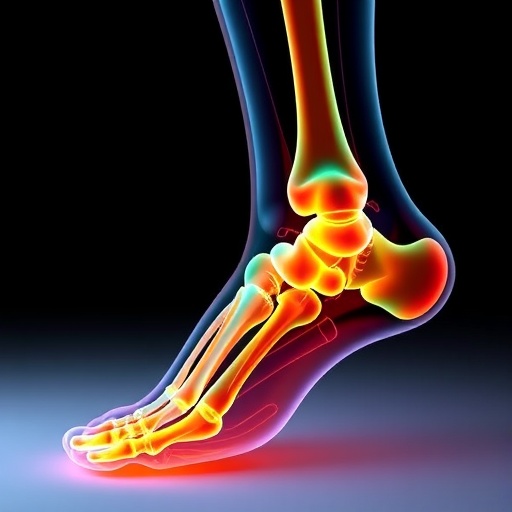In a groundbreaking study published in the upcoming issue of the Annals of Biomedical Engineering, researchers have taken significant strides in understanding a complex condition known as Progressive Collapsing Foot Deformity (PCFD). This condition, often overlooked in terms of comprehensive scientific inquiry, can severely impact mobility and quality of life for affected individuals. Through innovative multi-bone modeling and the precise measurement of joint-level dynamics, the team has detailed important findings that could reshape the management and treatment of this deformity.
The investigation sheds light on the intricate biomechanical interactions between the various bones and joints in the foot, providing an unprecedented look at how alterations in these components contribute to the progression of PCFD. The study forms part of a broader initiative aimed at enhancing our grasp of how orthopedic conditions develop over time, especially in conditions that may often be dismissed as degenerative or age-related.
Foot deformities such as PCFD can lead to a painful compromise in an individual’s ability to perform routine activities. The progressive nature of the condition not only affects physical well-being but can also pose psychological challenges. The researchers aim to elevate the scientific discourse surrounding this topic by presenting quantitative findings that elucidate the pathophysiological mechanisms at play.
The research team, led by K. Knutson, A.C. Peterson, and R.J. Lisonbee, meticulously documented the mechanics of foot bones and their movements through complex biomechanical simulations. These simulations were informed by a wealth of clinical data, including gait analyses and stress tests. By employing sophisticated imaging technology and computational modeling, the researchers crafted a dynamic narrative of how each bone and joint influences the overall structure and function of the foot under varying loads and conditions.
One of the most noteworthy aspects of the research is its focus on joint-level measurements. This objective approach allows the researchers to break down the interactions that occur at each joint, yielding insights that are essential for developing targeted interventions. Understanding that foot mechanics are a symphony of movements, derived from countless interactions among bones, ligaments, and tendons, the research elucidates how subtle variations in motion can lead to significant deformities over time.
Furthermore, Knutson and colleagues conducted extensive tests to assess the impact of different physical activities and how they exasperate or alleviate the symptoms associated with PCFD. They found that high-impact and repetitive activities tend to accelerate the progression of the deformity, whereas low-impact activities could preserve joint function for longer periods. These findings could be pivotal in informing rehabilitation protocols and advising patients on activity modifications tailored to their specific condition.
The implications of this research extend beyond immediate clinical applications. By providing quantifiable data, it opens new avenues for future studies into other orthotic and systemic conditions that affect the foot and overall gait dynamics. This rich dataset can serve as a foundational reference for future research, prompting further exploration into therapeutic interventions, potential surgical options, and prosthetic designs that could effectively address the challenges posed by PCFD.
Additionally, the study emphasizes the importance of early detection and intervention in cases of Progressive Collapsing Foot Deformity. As the analysis shows clear indicators of biomechanical deterioration, healthcare practitioners are encouraged to adopt a proactive stance toward monitoring patients at risk. Early measures may include tailored physical therapy regimens or lifestyle adjustments intended to offset the biomechanical stresses that contribute to symptom escalation.
The researchers also highlight that the socio-economic consequences of untreated PCFD can be dire. Given the prevalence of foot-related ailments in contemporary society, there is a pressing need for healthcare systems worldwide to prioritize orthopedic health alongside other chronic conditions. The insights drawn from Knutson et al.’s work advocate for policy changes within healthcare frameworks to ensure that foot health is given the same level of attention as more commonly recognized conditions.
This research not only marks a significant advancement in orthopedic biomechanics but also serves as a call to action for further exploration in the space of foot health. By raising awareness and stimulating discussion among professionals in biomechanics, orthopedics, and public health, the hope is that Progressive Collapsing Foot Deformity will garner the scientific scrutiny it has long deserved.
In conclusion, the multi-faceted approach adopted by the team behind this study illustrates the complexity of human biomechanics. It serves as a crucial reminder that our understanding of health conditions must evolve as we uncover the detailed interactions between anatomy and pathology. Ultimately, insights gained from such pioneering research can empower medical professionals to devise interventions that enhance mobility, improve quality of life, and mitigate suffering for millions of individuals facing the challenges inherent in Progressive Collapsing Foot Deformity.
In light of these findings, greater emphasis on education, early intervention, and ongoing research in the area of foot deformities may lead to more effective management and prevention strategies that benefit public health on a global scale.
Subject of Research: Progressive Collapsing Foot Deformity
Article Title: Progressive Collapsing Foot Deformity: Multi-bone Modeling and Joint Level Measurements
Article References:
Knutson, K., Peterson, A.C., Lisonbee, R.J. et al. Progressive Collapsing Foot Deformity: Multi-bone Modeling and Joint Level Measurements. Ann Biomed Eng (2025). https://doi.org/10.1007/s10439-025-03775-2
Image Credits: AI Generated
DOI:
Keywords: Biomechanics, foot deformity, Progressive Collapsing Foot Deformity, multi-bone modeling, joint-level measurement, rehabilitation, orthopedic health.




